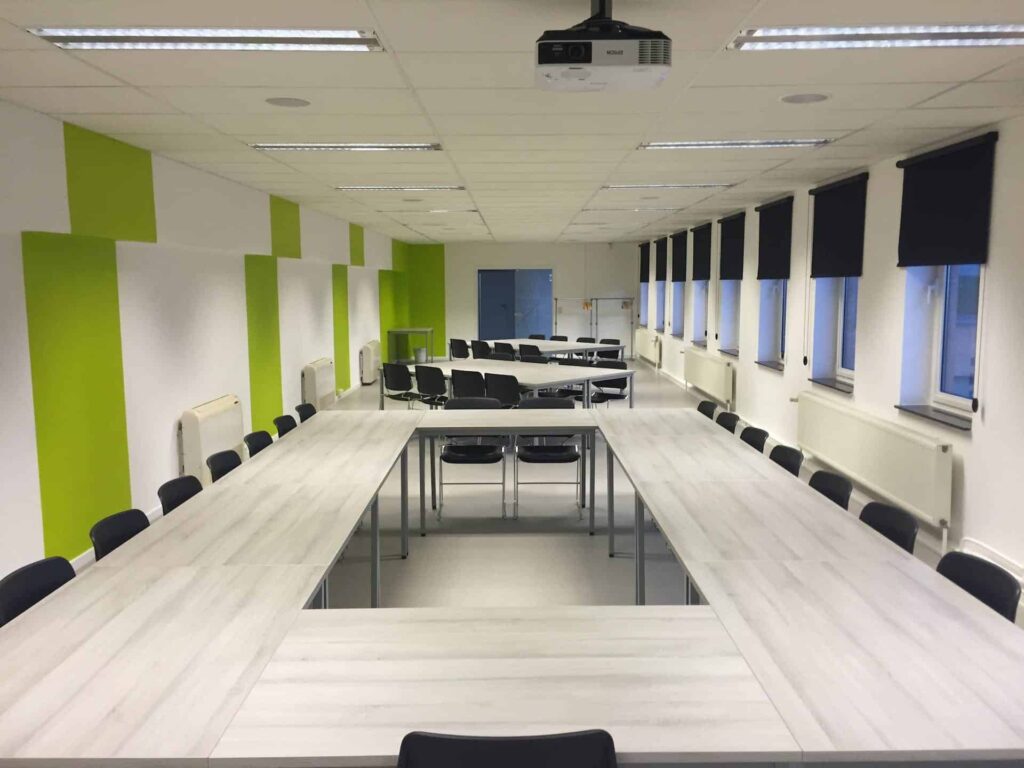Audio-visual technology, commonly referred to as AV, encompasses equipment and systems that combine sound and visual elements to enhance various forms of communication and entertainment. This technology is integral to experiences such as movies, television broadcasts, live performances, and corporate presentations. In essence, audio-visual systems are designed to transmit, process, and display content in a way that can be simultaneously heard and seen by an audience.
At its core, audio-visual technology includes both the tangible equipment—like microphones, speakers, projectors, and video displays—and the underlying techniques used to capture, edit, and produce content. As technology advances, AV systems are becoming more sophisticated, offering clearer pictures, superior sound quality, and more immersive experiences. These improvements have led to innovations across sectors, transforming how information is conveyed in educational spaces, how engagement is driven during live events, and how collaborations are facilitated in professional settings.
Key Takeaways
- Audio-visual technology merges sound and visual components to enhance communication.
- AV equipment and techniques are essential in media production, live events, and collaboration.
- Ongoing innovations in AV technology continue to refine and expand user experiences.
Fundamentals of Audio-Visual Technology
Audio-Visual (AV) technology orchestrates sound and video to create environments that engage audiences and facilitate communication and entertainment. This section elucidates the essential facets of AV technology.
Defining AV Technology
AV Technology is the convergence of audio (sound) and visual (video) components to deliver messages and experiences. They are integral to diverse fields such as education, corporate communication, and entertainment and encompass a broad spectrum of equipment like microphones and displays.
History and Evolution of AV
The journey of AV technology dates back to the early 20th century with the advent of cinema and public address systems. Rapid advancements in electronics have transformed AV from analog projectors and microphones to digital systems that blend sophisticated software with high-quality video and sound hardware.
Key Components of AV Systems
Modern AV systems rely on several key components to ensure seamless audio-visual experiences:
- Sound: This includes devices such as microphones and speakers essential for audio capture and playback.
- Video: Encompasses a range of displays, from traditional projectors to advanced LED walls, vital for visual presentation.
- Integration: Sound and video elements must be synchronized via a mix of hardware and software to facilitate cohesive AV experiences.
AV Technology in Media and Entertainment
Audio Visual (AV) technology serves as the backbone of contemporary storytelling and entertainment, combining sound and video elements to captivate audiences worldwide.
Audio-Visual Technology in Movies and Television
In movies and television, AV technology is crucial in shaping the viewer’s experience. Enhanced surround sound systems immerse audiences in the on-screen action, while advancements in high-definition video and special effects create visually stunning spectacles. The use of CGI (Computer Generated Imagery) in television has allowed for more intricate storytelling and engaging visuals, transforming the way narratives are delivered.
The Impact of AV on Live Performance and Music
Live performances and music rely heavily on AV technology to elevate the experience. Sophisticated lighting design creates the atmosphere, while sound engineering ensures music and spoken words are crystal clear. The incorporation of video projections and multimedia elements during live events further engages the senses, creating a multisensory event that resonates with audiences long after the curtains close.
Emerging Trends in Multimedia and Animation
Multimedia and animation represent a significant shift in AV technology, employing graphic design, 3D modeling, and interactive media to produce captivating exhibits and interactive experiences. These trends extend to augmented and virtual reality experiences, which use AV components to create immersive environments for both entertainment and educational applications. As the arts continuously evolve, these emerging trends in AV technology signify a limitless horizon for creative expression and innovation in media.
Technical Aspects of AV Equipment
Audio Visual (AV) technology encompasses a range of equipment crucial for creating immersive experiences. The technical aspects of AV equipment involve the selection, installation, and synergy between hardware and software components.
Understanding AV Hardware
AV hardware refers to the tangible components of an AV system. Speakers are essential for outputting audio and vary in size and power to suit different environments. Projectors and displays form the visual backbone, projecting images or video to screens or surfaces. In meetings and events, microphones capture audio and are available in various forms, such as lapel, handheld, or ceiling-mounted. The choice of AV hardware must consider the venue’s acoustics, ambient lighting, and audience size.
- Speakers: Tailored for environment acoustics
- Projectors/Displays: Adapted to ambient lighting conditions
- Microphones: Selected based on event type
The Role of AV Software
The software in AV systems plays a crucial role in how audiovisual content is delivered and experienced. It includes applications that enable control over hardware components, content management systems, and specialized programs for video conferencing and collaboration. Interfacing with APIs enables further integration and extensibility, allowing for customized solutions that can interact with other systems and devices.
- Control Applications: Interface with AV hardware
- Content Management: Streamlines deployment of AV media
- API Integration: Enhances system functionality
Installation and Setup of AV Systems
The installation and setup of AV systems require careful planning and design to align with the specific needs of a space. Technicians must map out the layout of AV equipment, ensuring optimal placement for unobstructed sound and visuals. Proper integration of hardware and software components is fundamental for seamless performance. Post-installation, the system is calibrated to ensure that the audio and video output quality meets professional standards.
- Installation Planning: Arranging equipment for optimal performance
- Integration & Calibration: Synchronizing hardware and software
This section conveys the essential technical features and workflow considerations of AV equipment, emphasizing the interplay between hardware, software, and the precise setup of AV systems.
Innovations in Audio-Visual Technology
The audio-visual sector is witnessing rapid advancements, marked by the integration of immersive technologies that enhance user experience and interaction. Here’s a closer look at some of the significant developments.
Virtual and Augmented Reality Applications
The use of virtual reality (VR) and augmented reality (AR) has created a transformative way for individuals to interact with digital content. With developer tools like ARCore and ARKit 4, big tech companies are fostering the creation of more immersive applications. Additionally, the inclusion of LiDAR technology in mobile devices has further enhanced mobile AR experiences, enabling richer interaction with the user’s environment.
Advanced Display Technologies
As part of advanced display technologies, 8K resolution is making noteworthy inroads within the market, establishing new standards for visual clarity and detail. 8K displays are gaining popularity, providing unprecedented image quality for both domestic and commercial settings. Visual displays are also evolving through innovative designs like LED video walls, which are increasingly used in public spaces, events, and professional environments for dynamic and scalable visual presentations.
High-Quality Audio Developments
The progression in audio technology has been equally impressive, with immersive audio systems like Dolby Atmos leading to a paradigm shift in acoustic experiences. These technologies create a three-dimensional soundscape, which allows audio to move in a spatial manner, providing a more realistic and engaging listening experience. Developments in wireless audio have facilitated the growth of high-quality headphones and portable speakers, reducing clutter and enhancing sound fidelity, while improving user convenience.
AV in Communication and Collaboration
Audio-Visual (AV) technology is a pivotal element in enhancing communication and collaboration in various settings, from corporate to educational environments. It offers dynamic ways to engage with content and connect individuals irrespective of physical distances.
Video Conferencing and Remote Work
Video conferencing systems have become integral to remote work, enabling real-time communication and collaboration across the globe. With high-quality audio and visual components, teams can engage in productive meetings, share content, and establish an interactive workspace without geographic limitations. This technology fosters a sense of presence and unity among remote participants, which is vital for maintaining team cohesion.
Digital Signage and Information Displays
Digital signage provides a versatile platform for communication, using displays to present multimedia content that can inform, engage, and influence behaviors. In public spaces, corporate environments, and retail settings, digital signs offer a dynamic method to circulate news, advertisements, and essential information to a broad audience. Interactive digital signage takes this a step further by allowing users to engage with the content, enhancing the communicative experience.
AV Integration in Educational Contexts
In education, AV technology has transformed traditional learning spaces into collaborative meeting spaces that encourage interactive learning. Tools such as smartboards and streaming services allow for dynamic presentations and the flexibility to access a vast array of educational resources. This integration supports diverse instructional strategies and caters to various learning styles, thereby enriching the educational experience for both teachers and students.
AV System Design and Management
In the realm of audio-visual technology, AV system design and management are pivotal for ensuring optimal performance and user experience. These processes encompass everything from the initial blueprint to the regular upkeep of AV systems.
The Importance of AV System Design
In designing an AV system, precision is key. It involves not only an in-depth understanding of the technical components but also a keen eye for how they will serve the users’ needs. Proper AV system design ensures seamless integration of audio and visual components, which can include systems from leading providers like Crestron and Control4. A well-designed system delivers on both functionality and aesthetics, creating environments that are both efficient and engaging.
Managing and Controlling AV Environments
Control systems serve as the cornerstone of managing and controlling AV environments. They provide a single interface for users to effectively handle diverse AV equipment. Integration of control systems enables users to manage their environment effortlessly, whether it’s adjusting lighting, sound, or visual displays. Companies like Crestron and Control4 specialize in creating control systems that cater to the nuanced needs of modern audio-visual technology.
AV System Maintenance and Troubleshooting
Regular maintenance is essential to sustain the performance and longevity of an AV system. This entails routine checks to ensure all components are functioning as intended, as well as timely updates to software and hardware. When issues do arise, troubleshooting is carried out by experienced professionals who can quickly identify and resolve problems, minimizing downtime and maintaining the integrity of the AV experience. The success of maintenance and troubleshooting significantly depends on the initial design and integration of the system since well-planned systems are often easier to maintain and troubleshoot.
By prioritizing AV system design and management, organizations can harness the full potential of audio-visual technology to create dynamic and effective environments.
Industry Standards and Manufacturers
In the realm of audiovisual (AV) technology, a combination of industry standards and prestigious manufacturers play crucial roles in ensuring quality and interoperability of AV equipment. Companies like LG stand at the forefront of technology, producing advanced equipment that aligns with rigorous standards. This section unpacks the major players in manufacturing, the importance of adherence to standards, and the pathways for professional growth and certification within this dynamic industry.
Overview of Major AV Manufacturers
Leaders in the AV industry, such as LG, Sony, and Samsung, are renowned for their innovative products that often set market trends. Each brand boasts a distinctive range of AV equipment designed to cater to diverse needs, from personal entertainment to large-scale event setups. The product lines from these companies include top-notch display panels, projectors, and audio systems that incorporate cutting-edge technology to enhance user experience.
Industry Standards and Compliance
Adopting industry standards is paramount to achieving uniformity and reliability in AV technology. Notable standards include those set by organizations like AVIXA, which ensure systems perform to their highest potential. These standards cover various aspects of AV systems, from audio coverage uniformity to AV/IT infrastructure guidelines for higher education, driving consistency across installations and designs.
Certifications and Professional Development
AV professionals often pursue certifications to demonstrate their expertise and commitment to quality. These credentials, such as CTS (Certified Technology Specialist) or more specialized certifications like CTS-D (Design) and CTS-I (Installation) from AVIXA, reflect an individual’s knowledge and adherence to industry standards. Furthermore, professionals with a degree in a related field may have more in-depth knowledge of AV technologies, which can be critical for advanced roles within the industry. Continuous learning and professional development are emphasized to keep pace with the rapid evolution of AV technology.
The Future of Audio-Visual Technology
Advances in technology continue to push the boundaries of what is possible in audio-visual experiences. With new developments in integration, resolutions like 8K, and the evolving landscape of streaming services, the future of AV is set to dramatically enrich media and entertainment.
Predictions and Upcoming Trends
In the realm of audio-visual technology, predictions are pointing towards immersive and interactive experiences taking center stage. The emergence of 8K resolution displays promises unprecedented image clarity that is poised to transform both consumer and professional markets. The integration of LED technology enhances this further, offering vibrant color fidelity and energy efficiency.
Streaming services are predicted to expand their use of advanced AV technology, with a pivot towards tailor-made content for an array of devices. Predictive analytics, fueled by AI, will drive content creation and delivery, ensuring that the viewing experience is personalized and of the highest quality.
The Convergence of AV and IT
The fusion of audio-visual and information technology reflects a significant shift in how both areas are managed within organizations. Businesses are now seeking integration of AV and IT systems through open standards and APIs, allowing for seamless operation and ease of use. This convergence is essential for supporting collaborative work environments and facilitating remote interactions that rely on high-quality AV communications.
The Role of AV in Future Media and Entertainment
In the world of entertainment, AV technology is a cornerstone for the next-generation media landscape. Films and television productions are utilizing technological advancements like high-resolution cameras and sophisticated sound equipment to produce content that is richer and more engaging than ever.
The future will see streaming not just as an alternative to DVDs but as the main platform for consuming media. With that, the rise of direct-to-consumer streaming options will grant audiences greater control over what they watch and how they watch it. Integrating streaming services into traditional cable and satellite offerings will be another major trend adapting to the viewer’s preference for a centralized and convenient source of entertainment.
Frequently Asked Questions
In this section, readers can find succinct answers to common queries about audio visual technology and its significance in various settings, detailing its impact on communication, careers, education, and technological advances.
How do Audio Visual Systems Enhance Communication?
Audio visual systems facilitate effective communication by combining sound and visuals to convey messages clearly and engagingly. They are crucial in settings ranging from corporate meetings to live events, helping to ensure that information is delivered in a way that is accessible and memorable to the audience.
What Careers are Available in Audio Visual Technology?
Careers in audio visual technology include roles such as audio visual technicians, system designers, and event production specialists. These professionals are tasked with setting up, operating, and maintaining audio visual equipment, ensuring high-quality sound and imagery for various applications.
Which Educational Path is Best for an Audio Visual Technology Career?
The best educational path for a career in audio visual technology typically involves a combination of formal education—such as a degree in broadcast technology or multimedia—and hands-on experience. Obtaining certifications from AV industry bodies can also bolster one’s qualifications and job prospects.
What Role Do Audio Visual Aids Play in Education?
Audio visual aids play a pivotal role in education by enhancing the learning experience. These tools can make educational content more accessible and easier to understand, thereby improving students’ ability to retain and engage with material.
How Has Audio Visual Technology Evolved in Recent Years?
In recent years, audio visual technology has seen significant advancements through the integration of digital interfaces, wireless connectivity, and high-definition displays and sound systems. These developments have led to more immersive and user-friendly AV solutions across various sectors.
What are the Most Innovative Audio Visual Technologies Today?
Today’s most innovative audio visual technologies include virtual and augmented reality systems, 4K ultra-high-definition displays, and advanced audio systems that provide spatial sound experiences. Innovations in audio visual technology are continually setting new standards for interactivity and immersive experiences.



